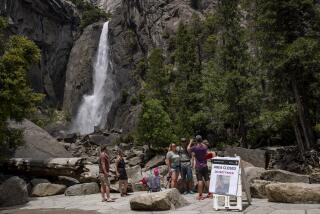Opportunity in Disaster
- Share via
National Park Service officials should take advantage of the silver lining in the rain clouds that produced record flooding in Yosemite. The havoc wreaked by the Merced River, which runs through the park’s valley, has also created an opportunity for change and renewal.
Since it became a national park in 1890, Yosemite has become steadily more popular--and more crowded. Last year’s 4.1 million visitors intensified the already extreme pressure on park facilities, especially those campgrounds, concessions and roads in Yosemite Valley. This dynamic has made it increasingly difficult for Park Service officials to maintain the splendor of the valley, which is only a mile wide and seven miles long.
The havoc began after warm rain fell around New Year’s on snowpack in the park’s upper reaches and produced far more runoff over Yosemite Falls than the river could accommodate. The worst flooding in recent memory inundated the valley, once a glacial lake. Water covered campgrounds, upended park buildings and vehicles, washed out major roads, obliterated popular beaches, forged new channels and flooded meadows.
Although Yosemite’s southern entrance opened Wednesday, Yosemite Valley will be closed to the public until at least March as the park staff contemplates how to deal with damage estimated at $50 million.
The opportunity lies in what comes next. Park officials, along with lawmakers and the Interior Department, are weighing whether to simply repair the damage or whether it is time to implement the bulk of the master plan drawn for the park 17 years ago. Indeed it is time.
Shrinking and concentrating visitor services in the valley, says park superintendent B.J. Griffin, should prevent future flood damage while mitigating problems caused by congestion and deepening visitors’ experience of nature. The 1980 master plan, drafted when crowding already was onerous, suggested keeping the valley’s lodgings intact but removing about one-quarter of the remaining buildings, moving worker accommodations and offices out of the valley, relocating campgrounds and outdoor facilities away from the river and letting more than 100 acres of riverfront and meadows revert to nature.
In an effort to meet the master plan’s broad goal of reducing congestion, some campgrounds have been closed over the last five years and incoming traffic has been delayed at times.
The result of more of these sorts of efforts would be immediately obvious in cleaner air over the valley, in views unobstructed by knots of fast food stands and motor homes and in the expansion of such naturalist activities as hiking. Yosemite now has a chance to reclaim and preserve more of its priceless natural beauty and give its visitors greater opportunity to enjoy that splendor. Such have been the primary missions of the national parks since 1872 when Congress established Yellowstone as the first.
In 1898, the naturalist John Muir wrote that “thousands of tired, nerve-shaken, over-civilized people are beginning to find out that going to the mountains is going home; that wildness is a necessity; and that mountain parks and reservations are useful not only as fountains of timber and irrigating rivers but as fountains of life.”
A century later, Yosemite superintendent Griffin faces a tough sell, both locally and in Washington, in seeking to reinvigorate Muir’s vision at the park. But should she succeed--and we hope she does--Yosemite could be a model for the many other national parks facing the dilemmas created by our need to go home to mountain wildness.
More to Read
Sign up for The Wild
We’ll help you find the best places to hike, bike and run, as well as the perfect silent spots for meditation and yoga.
You may occasionally receive promotional content from the Los Angeles Times.






